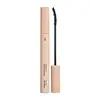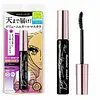What's inside
What's inside
 Key Ingredients
Key Ingredients

 Benefits
Benefits

No benefits
 Concerns
Concerns

 Ingredients Side-by-side
Ingredients Side-by-side

Isododecane
EmollientTrimethylsiloxysilicate
EmollientTalc
AbrasiveCeresin
Emulsion StabilisingDisteardimonium Hectorite
StabilisingDextrin Palmitate/Ethylhexanoate
EmulsifyingCI 77499
Cosmetic ColorantMicrocrystalline Wax
Emulsion StabilisingPolypropylsilsesquioxane
Hydrogenated Polyisobutene
EmollientPropylene Carbonate
SolventNylon-6
Aluminum Distearate
Emulsion StabilisingPolymethylsilsesquioxane
Triethoxycaprylylsilane
Glyceryl Caprylate
EmollientSilica
AbrasiveIsododecane, Trimethylsiloxysilicate, Talc, Ceresin, Disteardimonium Hectorite, Dextrin Palmitate/Ethylhexanoate, CI 77499, Microcrystalline Wax, Polypropylsilsesquioxane, Hydrogenated Polyisobutene, Propylene Carbonate, Nylon-6, Aluminum Distearate, Polymethylsilsesquioxane, Triethoxycaprylylsilane, Glyceryl Caprylate, Silica
Isododecane
EmollientTrimethylsiloxysilicate
EmollientTalc
AbrasiveSericin
Skin ConditioningHydrogenated Polyisobutene
EmollientDisteardimonium Hectorite
StabilisingDextrin
AbsorbentMicrocrystalline Wax
Emulsion StabilisingHoney
HumectantPropylene Carbonate
SolventPrunus Amygdalus Dulcis Oil
Skin ConditioningCamellia Seed Oil
Argania Spinosa Kernel Oil
EmollientRosa Canina Fruit Oil
EmollientDaucus Carota Sativa Root Extract
Skin ConditioningRoyal Jelly Extract
Skin ConditioningAluminum Distearate
Emulsion StabilisingPolymethylsilsesquioxane
Glyceryl Isostearate
EmollientZinc Laurate
Silica
AbrasiveSqualane
EmollientTocopherol
AntioxidantAscorbyl Dipalmitate
AntioxidantCI 77492
Cosmetic ColorantIsododecane, Trimethylsiloxysilicate, Talc, Sericin, Hydrogenated Polyisobutene, Disteardimonium Hectorite, Dextrin, Microcrystalline Wax, Honey, Propylene Carbonate, Prunus Amygdalus Dulcis Oil, Camellia Seed Oil, Argania Spinosa Kernel Oil, Rosa Canina Fruit Oil, Daucus Carota Sativa Root Extract, Royal Jelly Extract, Aluminum Distearate, Polymethylsilsesquioxane, Glyceryl Isostearate, Zinc Laurate, Silica, Squalane, Tocopherol, Ascorbyl Dipalmitate, CI 77492
 Reviews
Reviews

Ingredients Explained
These ingredients are found in both products.
Ingredients higher up in an ingredient list are typically present in a larger amount.
We don't have a description for Aluminum Distearate yet.
Disteardimonium Hectorite comes from the clay mineral named hectorite. It is used to add thickness to a product.
It can also help stabilize a product by helping to disperse other ingredients.
Hectorite is a rare, white clay mineral.
Learn more about Disteardimonium HectoriteHydrogenated Polyisobutene is a synthetic polymer. Polymers are compounds with high molecular weight. Hydrogenated Polyisobutene is an emollient and texture enhancer.
In one study, Hydrogenated Polyisobutene showed better skin hydration levels than Caprylic/Capric Triglyceride. As an emollient, it helps keep your skin soft and hydrated by trapping moisture in.
Hydrogenated Polyisobutene is often used as a mineral oil replacement.
Learn more about Hydrogenated PolyisobuteneIsododecane is a fragrance, emollient, and solvent.
As an emollient, it helps your skin stay soft and hydrated. Emollients help trap moisture into your skin.
Isododecane's role as a solvent makes it a great texture enhancer. It spreads smoothly on skin and does not leave a sticky feeling behind. Isododecane also helps prevent color transfer in makeup products.
Isododecane is not absorbed into skin.
Learn more about IsododecaneMicrocrystalline Wax is created by de-oiling petroleum. It is highly refined and purified before being added to cosmetics.
Microcrystalline Wax is used to enhance the texture and create even consistency. It helps stabilize a product by preventing ingredients from separating.
Polymethylsilsesquioxane is a silicone used as a film forming agent.
When applied to the skin, this ingredient creates an invisible film on the surface. This film still allows oxygen to pass through, but prevents moisture from escaping. This can help condition and hydrate the skin. It also leaves a silky feel when applied.
Polymethylsilsesquioxane has not been shown to clog pores. It has been deemed safe to use up to 55%, but most cosmetics use much less.
If you have concerns about using this ingredient, we recommend speaking with a professional.
Learn more about PolymethylsilsesquioxaneThis ingredient is a solvent. It helps dissolve active ingredients and alter the texture of products.
Propylene Carbonate is commonly used in makeup and with clay, such as montmorillonite or bentonite.
Studies show this ingredient to be safe for cosmetics. When it is undiluted, it can cause skin irritation. (It is always diluted in skincare and makeup). This ingredient is water-soluble.
Propylene Carbonate is created from propylene glycol and carbonic acid.
Learn more about Propylene CarbonateSilica, also known as silicon dioxide, is a naturally occurring mineral. It is used as a fine, spherical, and porous powder in cosmetics.
Though it has exfoliant properties, the function of silica varies depending on the product.
The unique structure of silica enhances the spreadability and adds smoothness, making it a great texture enhancer.
It is also used as an active carrier, emulsifier, and mattifier due to its ability to absorb excess oil.
In some products, tiny microneedles called spicules are made from silica or hydrolyzed sponge. When you rub them in, they lightly polish away dead skin layers and enhance the penetration of active ingredients.
Learn more about SilicaTalc is a clay mineral. It helps absorb moisture and improve the texture of products. Like other types of clay, Talc can have a slight exfoliating effect on skin. Talc can be added to increase the volume of products.
Some Baby powders are made by combining talc with corn starch. The word "talc" comes from Latin and originates from Arabic. Talc is a mineral commonly found throughout the world.
If you have any concerns about using talc, we recommend checking out the FDA's official page.
Learn more about TalcThis silicone is an emollient. Emollients create a thin film on the skin to prevent moisture from escaping.
It is not soluble in water and helps increase water-resistance in products.
According to a manufacturer, it can blend seamlessly with silicone oils, such as Cyclopentasiloxane.
Learn more about Trimethylsiloxysilicate